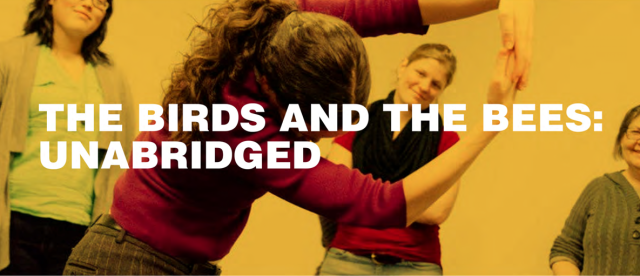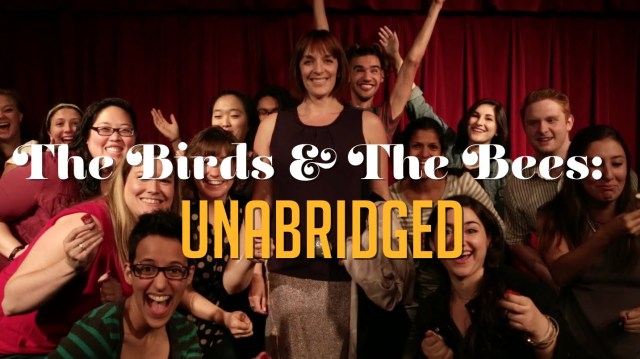At Autostraddle, we love Maggie Keenan-Bolger and her work. So when Honest Accomplice Theatre landed another surprise run of The Birds and the Bees (a devised theatre piece about sex and sexuality from a queer perspective) and released their new survey (which you should totally take), I decided it was time to catch up with Maggie Keenan-Bolger and Rachel Sullivan about their non-profit theatre company, their show and their process. Both amazing women answered the questions together. The interview has been edited for length and clarity.
First, we’d love to hear a little bit about the Birds and the Bees — what is the project? What does it mean to y’all? And how has it changed since we last chatted about it on Autostraddle?
The Birds and The Bees: Unabridged explores the unique – yet interwoven – life circumstances of eight people forced to confront their own sexuality, realizing that sexuality itself is not simple or clear-cut. Through dialogue, movement, song, humor, and multimedia, the performance examines such themes as partner communication, sexual identity, the de-sexualization of aging women, today’s “hook-up” culture and sexual health.
The show was created with the process of devising where the script is developed from the ideas, opinions, stories, and efforts of over 50 performers, audience feedback, as well as over 2,000 respondents to a nationwide survey we launched in 2012. We believe the creation of new work is vital to counteract mainstream art, which often ignores, or misrepresents the voices and interests of our diverse participants.
We’ve actually been working on this piece for the last four years and the show has seen many incarnations. It started when we were frustrated by the limited perspectives and representations of female sexuality in our world. When we first began the creation process we didn’t have a script, a cast, or even an outline; we just knew sexuality was a topic that interested us and seemed rich for exploration. We reached out to friends and colleagues to see if they were interested in discussing the topic as well. It turned out that, when given the opportunity, people could talk for hours. After holding some preliminary workshops, we disseminated a survey to see what people around the country were interested in seeing discussed and to get the stories of those outside of our social circles. We were hoping for 500 or so responses and we got 2,000! The survey also made it clear that people wanted us to include trans issues in our exploration as well. So, from there, we created a community of both cis and trans people of varying genders (some professional actors, some who had never been on stage before) from a variety of backgrounds. And after many many hours of rehearsal we developed the first performance.
The show has changed quite drastically from our first run. The performance began as “a quilt of scenes” loosely held together by the theme of sexuality. This version was well received, but we realized the audience was craving more narrative and connection to characters. In 2014 we adapted the script to include 8 characters who grow and develop through the story and are impacted by the interactions they have with the other characters on stage. Finally, we’ve incorporated a lot of fun multimedia components which have allowed us to showcase performers from even more backgrounds and identities.
We work for people to see, share, and celebrate the options of being and living one’s life. We push our audiences and artists to ask difficult questions and present difficult situations on stage, offering entry points for empathy and awareness. We want to give our audiences and company members a chance to be part of a group/collective and to challenge people’s views on the world and each other. We hope that our artists and audiences are stimulated to make the small changes in their life that lead to the big global shifts. We create to see the small, beautiful moments between people and hope our audiences leave a performance or work feeling enriched, intrigued, and a little less alone in the world.
One of our audiences members wrote:
“I cried on the subway the first night I saw it (The Bird and the Bees: Unabridged). Just knowing people want to talk about this removes such a burden from me.”
This keeps us going.

Could you explain the process of devising a piece of theatre? Would you call Devised Theatre a genre unto itself, or something else entirely?
There is no one way to devise a show, so we can’t speak for everyone, but our process of creating The Birds and the Bees: Unabridged looked something like this:
We started with idea for a show (female sexuality), began researching, talking and asking questions of anyone who would speak with us, we disseminated a survey, and formed a creative ensemble to devise the show with us.
During the rehearsal process we brainstormed for weeks, created many different characters, moments and scenes. We offered prompts to the group (shocking statistics about sexuality, provoking sexualized images, a pile of products traditionally seen as ‘feminine’ or ‘sexual’) and had the ensemble develop scenes. From those scenes, we found snippets of inspiration that we worked with to turn into a full fledged theatre piece.
Then we tossed about 90% of the work we developed (a normal part of the devising process) mourned those losses, and began to explore the 10% we kept. Every rehearsal would involve new ideas, new moments, and then post rehearsal meetings where we (Maggie and Rachel) would make edits and suggestions. These edits were shared with the cast and we made more edits off of their recommendations.
We shared the work with trusted colleagues, received feedback, made revisions, and continued the process.
There’s no definitive end point because the work is always shifting if ever so slightly. Just this past week we changed some lines. It’s always being shaped by our performers, current events, and more.
Devised Theatre is really a melting pot of many genres. We use theatre, dance, music, multimedia, writing, clowning and so many other techniques to create our shows. We often include whatever skills are held by the performers in our ensemble. We have a singing/dancing group right now so Birds and Bees has a big ol’ musical number. And we also have some folks who are great at miming and movement work, so you’ll see those styles too. The options are endless and we are excited to see what styles we’ll be able to utilize in the next show!
Maggie, correct me if I’m wrong, but this isn’t the first piece of Devised Theatre you’ve helped create that speaks directly to and about the queer community. Is there something about the practice of devising a piece of theatre that is especially effective to the queer community, or to marginalized communities in general?
Both of us have done extensive work in the queer community. With the company Urban Stages we created a theatre program for LGBT homeless youth at Green Chimneys. We’ve produced two shows (Queering History and Not Just Another Coming Out Story) written with LGBT homeless youth where they performed alongside Broadway actors!
As with so many marginalized communities, the mainstream narratives for queer characters (when they exist) have been written for us instead of by us. Devising offers the chance for queer people of all backgrounds and identities to decide what issues they want to see, who they want to see representing the issues, and how they want those issues to be shown. Similarly, there is a long history of heterosexual actors playing queer characters and, in particular, cisgender actors playing trans characters. While this is often necessary in the progression of marginalized characters represented on tv and in movies, we’re getting to the point where we don’t think we should settle for only seeing straight and cis performers on our stages or screens!
Theatre has traditionally been very welcoming to the LGBT community, but most often the perspectives shown are those of white, cis, gay men. They are also the people usually given the opportunity to produce, direct, write, etc. As a result, the scope of how the LGBT community is portrayed has been pretty limited. With devising, we have the chance to cast and present characters who are queer black women, non-binary trans people, and other intersectional identities that are not usually given a voice. Even better, it’s not just the two of us creating those characters from our own limited perspectives. Cast members in a devised show are able to create and develop honest depictions of characters who hold the same identities as the actors. These representations are far more complex, interesting, and truthful than characters we as directors and creators could develop on our own.
If any of our readers wanted to jump into devised theatre as a means to express their own community’s collective wants and needs, where should they start?
Listen and begin conversations! It’s important to find out what your community wants to discuss and explore. The best devised theatre comes from topics that elicit strong feelings in people, be it anger, excitement, confusion or fear. Stay tuned into the world and recognize when those feelings come up for you. Chances are good you aren’t alone. Find a community of people who feel similarly. We would never be able to do our work without the incredible support of over a hundred performers, volunteers, designers, and more.
While working on a piece, find a sense of humility and realize that you need to let go of what you originally thought the project would look like and leave room for the participants to add their mark and shape to the piece. (It’s usually better than what you could do on your own anyways.)
Ask trusted artists you know for help, feedback, ideas, and more. We were lucky to build a community of trusted colleagues and receive training in devising through the Applied Theatre program at The School of Professional Studies at CUNY. Honest Accomplice is also here to help with one-on-one meetings and workshops; we have advised other companies and artists who are delving into devised work.
See as much original, devised, and community based art as you can pack into your schedule! Discover what you like and dislike, what techniques are exciting, and brainstorm how you can borrow and alter ideas to put into your own practice.
Do it! There are many great books that can give you the foundations of devising, but ultimately you just need to get out there, try, fail, try again, and begin to find your own way of making the work. If you’re interested in becoming an actor who devises, get involved with companies and artist who utilize this method of creation. We are constantly holding auditions and opportunities for actors and non-actors to participate as performers, volunteers, designers, and more!

Is there anything you hoped I would ask that I didn’t? If so, please share anything you want our readers to know!
If you are reading this article, our guess is that sexuality and/or theatre is important to you. We’d love to hear your thoughts about topics for our next show! Honest Accomplice released our Survey for New Work on Oct 5th to determine our upcoming season! It only takes 5 minutes and your responses are crucial in our development process.
We also invite everyone to join our Queer Women and Trans People in the Performing Arts group, a networking group that meets for lectures/screenings/shows/get togethers.
